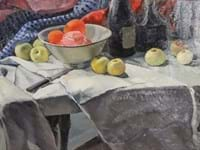
Going to the Pictures was estimated at Aus$2.5m-3.5m in Melbourne on November 11 but was knocked down for Aus$2.4m (£1.32m) to a private collector, the same sum fetched by Grandma’s Sunday Walk, offered at Mossgreen in June 2017.
With premium, the price was Aus$2.95m and the result was the highest achieved for an Australian artist at auction in 2020. It was also the seventh-highest price for any Australian picture – a list still led by Sidney Nolan’s First-Class Marksman from 1946 that took Aus$4.5m (£2.75m) at Menzies in 2010.
Going to the Pictures was consigned by descendants of the well-known journalist Clive Turnbull. The writer and art critic at three newspapers (the Melbourne Herald, the Argus and The Age) had acquired the signed oil on canvas at Drysdale’s landmark exhibition at Macquarie Galleries in 1942, the year after it was painted.
It was one of four famous outback scenes in the show. The others are now in the Queensland Art Gallery, the University of Sydney Art Collection and the Newcastle Region Art Gallery.
The 18 x 22in (46 x 56cm) work remained in Turnbull’s family after his death in 1981 and over the years it has been well exhibited, appearing at frequent shows of the artist’s work and being on loan at the National Gallery of Victoria from 2009-16.
Trademark features
Going to the Pictures, although painted when Drysdale lived in Sydney, was an attempt to reflect the experience of rural life in Australia and convey its remoteness. It was painted in the artist’s trademark style which blends landscape painting with Surrealism.
Drysdale was born in Sussex in England but his family moved to Melbourne in 1923. They had extensive agricultural interests and Drysdale was headed for a life on the land, but changed direction after meeting George Bell, the influential Modernist and art teacher.
Having seen Impressionist and other Modern works in Europe in the early 1930s for the first time, Drysdale decided to pursue a career as an artist and enrolled at the Shore-Bell School in Melbourne.
His works mainly tackled themes relating to his homeland including the effects of drought, environmental degradation and Aboriginal dispossession.
However, he managed to gain international recognition, exhibiting at London’s Leicester Galleries and with the Metropolitan Museum of Art in New York and the Tate in London both buying examples of his work.
Australian big-hitters
Today Drysdale is one of only five Australian artists who have broken the Aus$2m barrier at auction (the others are John Brack, Sidney Nolan, Brett Whiteley and Fred Williams).
The Drysdale painting provided a useful chunk of the overall premium-inclusive Aus$13.1m (£7.18m) total at Deutscher and Hackett.














